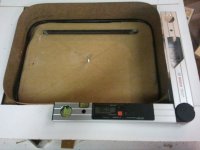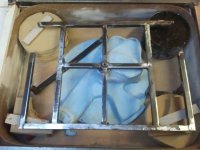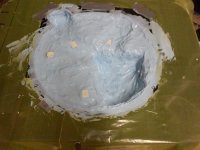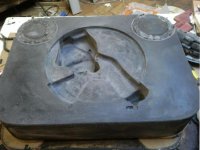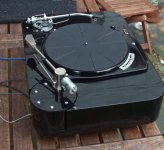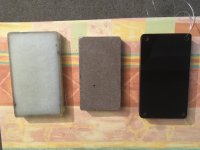Siberia-
Thanks for the link, although many of the photos were disabled.
Regarding the measurements: For the resonant frequency on single materials, I supported the panels on two "points" from below and one adjustable height point from the top (to keep the panel level); see photos in post #2 of this thread. It had to be supported that way because if you clamp the material tightly, it will be damped and will not resonate at the same frequency. I believe Cats Squirrel suspended the panel from a string which will also allow it to resonate freely, but the panel will hang vertically and needs to be struck with a hammer from the side to excite it. By keeping the panel horizontal, I was able to drop a golf ball from the same height each time so the relative amplitude of the impulse was the same for all panels and all tests.
For the composite damping tests, I supported the panel on four legs, similar to how it would be used as a plinth and dropped the golf ball from the same height as before.
The measurements were made with an Analog Devices ADXL-327 accelerometer attached to the panel with thin double sided tape, powered by 2 lithium ion cells. The output is directly connected to the audio input of my laptop, running Arta analyzer software.
Thanks for the link, although many of the photos were disabled.
Regarding the measurements: For the resonant frequency on single materials, I supported the panels on two "points" from below and one adjustable height point from the top (to keep the panel level); see photos in post #2 of this thread. It had to be supported that way because if you clamp the material tightly, it will be damped and will not resonate at the same frequency. I believe Cats Squirrel suspended the panel from a string which will also allow it to resonate freely, but the panel will hang vertically and needs to be struck with a hammer from the side to excite it. By keeping the panel horizontal, I was able to drop a golf ball from the same height each time so the relative amplitude of the impulse was the same for all panels and all tests.
For the composite damping tests, I supported the panel on four legs, similar to how it would be used as a plinth and dropped the golf ball from the same height as before.
The measurements were made with an Analog Devices ADXL-327 accelerometer attached to the panel with thin double sided tape, powered by 2 lithium ion cells. The output is directly connected to the audio input of my laptop, running Arta analyzer software.
Thank you, Pyramid for the elucidation on your measurement setup.
I might replicate it to compare my hopefully soonfinished plinth vs the old one.
Attached some of the Raps pics from the linked thread,
that I have found in my archives.
Mould preparation and close to/finished product.
The rationale and the polyester/bentonite mix you can find in the thread.
I might replicate it to compare my hopefully soonfinished plinth vs the old one.
Attached some of the Raps pics from the linked thread,
that I have found in my archives.
Mould preparation and close to/finished product.
The rationale and the polyester/bentonite mix you can find in the thread.
Attachments
Corian CLD plinth
Hi bgruhn,
I'm thinking about trying what you've suggested.
When you attached the bearing well and tonearm to your Corian CLD plinth, did they go through all three Corian layers? I.e. did they compress the layers together? Or, did the outer two layers remain attached only by the ice and snow shield?
Hugh
Hi Pyramid, (here come a long one)
For a picture please go to www.apricot.com/~bgruhn/turntable/77.jpg. I am still using that TT but have made a few changes. For one thing the WellTempered arm has been replaced with a linear tracking arm. You will note on the picture that there is an upper and a lower Corian plate separated front and rear by a seperate 3/4" square piece of corian. ...
What I had learned in the interim was that CLD could very well be that something. I had some leftover snow & ice shield material from a roofing job. It was the thicker type with sticky black adhesive coating on one side. This I cut into inch wide strips and applied it to the separator pieces essentially gluing the top plinth and bottom plinth together. The result was nothing short of amazing. Tapping on the edge of the playing record gives only a barely audible dull sound that dies out instantly...
BillG
Hi bgruhn,
I'm thinking about trying what you've suggested.
When you attached the bearing well and tonearm to your Corian CLD plinth, did they go through all three Corian layers? I.e. did they compress the layers together? Or, did the outer two layers remain attached only by the ice and snow shield?
Hugh
I just picked up a CL plinth built by Victor (JVC) with two arm boards for a Victor TT 71 motor drive. It's a 7 layer sandwich, alternating between wood and a VE material, topped with rosewood veneer. 2-3/8" thick and very massive.
Supposedly it was a massive undertaking with a lot of calculations for the Victor engineering department to come up with this design. Back in 1981 it cost about 40,000 Yen, considerable money.
The stock arm boards are 3 layer CL design as well and are 3/4" thick. The rear board has been drilled but the one on the RH side has not. I am going to duplicate the arm boards in aluminum plate and make several to try out my small collection of tonearms.
BillWojo
Supposedly it was a massive undertaking with a lot of calculations for the Victor engineering department to come up with this design. Back in 1981 it cost about 40,000 Yen, considerable money.
The stock arm boards are 3 layer CL design as well and are 3/4" thick. The rear board has been drilled but the one on the RH side has not. I am going to duplicate the arm boards in aluminum plate and make several to try out my small collection of tonearms.
BillWojo
as ALWAYS, there seems to be a complete misunderstanding as to what cld (constrained layer damping) is. It is NOT three or more layers of different (or the same) materials, stuck together in layers in the vain hope that vibrations will be tamed. Some vibrations may be tamed, but not by the cld principle.
True cld is a thin panel of a vibrating, low damping material covered with a very thin viscoelastic layer, which is constrained by another thin layer of material, often the same as the first layer.
I have used 3M 2552 'damping tape', which is 0.25mm of aluminium foil (10 mil in old money) with a 0.13mm (5 mil) viscoelastic layer. It is expensive (over £100 per roll), and it works.
The cld layer works by constraining the shear (sideways movement) of the viscoelastic layer. If this isn't allowed to happen ( by massive constructions), it will not work.
Corian ® has about the same damping factor as birch ply, that material so beloved of audiophiles, which does very little to damp vibrations. In fact, there is no need to use true cld if plinth materials are chosen carefully, and use materials which have high intrinsic damping. Same goes for arm boards.
True cld is a thin panel of a vibrating, low damping material covered with a very thin viscoelastic layer, which is constrained by another thin layer of material, often the same as the first layer.
I have used 3M 2552 'damping tape', which is 0.25mm of aluminium foil (10 mil in old money) with a 0.13mm (5 mil) viscoelastic layer. It is expensive (over £100 per roll), and it works.
The cld layer works by constraining the shear (sideways movement) of the viscoelastic layer. If this isn't allowed to happen ( by massive constructions), it will not work.
Corian ® has about the same damping factor as birch ply, that material so beloved of audiophiles, which does very little to damp vibrations. In fact, there is no need to use true cld if plinth materials are chosen carefully, and use materials which have high intrinsic damping. Same goes for arm boards.
Rectangular vs Skeletal Plinth
Hi Bryan,
I'm thinking about making a plinth from some 20mm Panzerholz that I bought. Is the Critical frequency effected by the width and depth, or just the thickness?
If I go with a skeletal style similar to what Clearaudio makes, I'm thinking that will spread out the resonances better than a conventional rectangular one. Pros and Cons? Do you (or anyone else) have any thoughts or advice? It would be very much appreciated.
Thanks,
Hugh
In my (imaginary) book, plinths need to be thin and made of appropriate materials. They need some bending stiffness, but not too much, and have a little mass, but, again, not too much. And high damping factors are mandatory, as it impinges on the whole structure. Fundamental frequency needs to be low, and critical frequency high. Apart from that, you can do what you like!
Hi Bryan,
I'm thinking about making a plinth from some 20mm Panzerholz that I bought. Is the Critical frequency effected by the width and depth, or just the thickness?
If I go with a skeletal style similar to what Clearaudio makes, I'm thinking that will spread out the resonances better than a conventional rectangular one. Pros and Cons? Do you (or anyone else) have any thoughts or advice? It would be very much appreciated.
Thanks,
Hugh
Hello Hugh,
A rectangle of Panzerholz, 20mm thick, is , in my opinion, about the best that we can do.
Critical frequency (above which all vibrations are audible) is only dependent on thickness regarding size, and not on width, etc.
HTH, I wish you a Happy New Year, and that we all pull through the prevailing conditions! Stay safe.
A rectangle of Panzerholz, 20mm thick, is , in my opinion, about the best that we can do.
Critical frequency (above which all vibrations are audible) is only dependent on thickness regarding size, and not on width, etc.
HTH, I wish you a Happy New Year, and that we all pull through the prevailing conditions! Stay safe.
I didn't measure it, but it is quite different. Lower density & lower bending stiffness for starters.
Bryan did some measurements wrt to Fc and damping here: https://qualia.webs.com/plinthbuilding.htm
Bryan did some measurements wrt to Fc and damping here: https://qualia.webs.com/plinthbuilding.htm
Pyramid,
I was wondering how close 1/2" Acrylic sheet (plexiglass) is to Corian? Did you try to measure any?
From the measurements I made:
acrylic 0.07
Corian ® 0.044
Acrylic is approaching the region which we might call 'damping', but the Corian ® certainly is not. Surprising, as from what I understand, Corian ® is acrylic filled with hydrated alumina. And filled polymers can have excellent properties. HTH
I am firmly in the resin/bentonite camp, having made 8 molded plinths for Technics SP10 mk2 and 10R turntables. One advantage of acrylic over bentonite resin is the dimensional stability. In thin layers as preferred by Cats Squirrel, the resin/bentonite does warp while curing. This is a problem when used for armboards, but still occurs in 90mm thick plinths. I found that 25mm thick acrylic armboards made from 3 laminated layers performed almost as well as resin/bentonite of identical thickness. The acrylic armboard was much quicker and easier to make.Pyramid,
I was wondering how close 1/2" Acrylic sheet (plexiglass) is to Corian? Did you try to measure any?
Subjectively the sound signatures of the freely suspended resin/bentonite and acrylic armboards pinged with a hammer were similar. In contrast an armboard of fibre re-inforced resin gave a much more resonant signature.
Attachments
Hi guys.
My turn to contribute to the construction of a good, stable plinth. It is very hard finding Panzerholz in large enough pieces to construct some plinth designs. How about another highly compressed plywood called Diamondply. You can get a slab that is 24+" x 16+" x 2" thick !!! However, be warned, This not a totally finished product and will require some machining to get an even thickness and your particular dimensions. I have made a plinth using this plus 1/2" corian on both top and bottom.
Dymondwood Handle Material
Steve Guttenberg has done two videos on my speakers and machine shop ( diy turntable ) I have changed the plinth from granite / stainless steel to what I mentioned above. Still working on the linear arm and a few other things.
Meet Joe, and his amazing DIY horn speakers - YouTube
I hope this info helps !!!
Best of luck,
Joe
My turn to contribute to the construction of a good, stable plinth. It is very hard finding Panzerholz in large enough pieces to construct some plinth designs. How about another highly compressed plywood called Diamondply. You can get a slab that is 24+" x 16+" x 2" thick !!! However, be warned, This not a totally finished product and will require some machining to get an even thickness and your particular dimensions. I have made a plinth using this plus 1/2" corian on both top and bottom.
Dymondwood Handle Material
Steve Guttenberg has done two videos on my speakers and machine shop ( diy turntable ) I have changed the plinth from granite / stainless steel to what I mentioned above. Still working on the linear arm and a few other things.
Meet Joe, and his amazing DIY horn speakers - YouTube
I hope this info helps !!!
Best of luck,
Joe
Hi, cats squirrel
I realize that making a proper turntable plinth can be complicated but I don't have a degree in Physics, Material science, or Acoustical engineering. I still need a proper, sturdy, plinth to mount a 55lb. platter plus 45+ pounds for bearing assembly, arm mounts, arm boards, and feet. My plinth was completed last June, just before this topic was discussed.
I would like to thank Pyramid and you for your contributions and insight into this topic.
All the best,
Joe
I realize that making a proper turntable plinth can be complicated but I don't have a degree in Physics, Material science, or Acoustical engineering. I still need a proper, sturdy, plinth to mount a 55lb. platter plus 45+ pounds for bearing assembly, arm mounts, arm boards, and feet. My plinth was completed last June, just before this topic was discussed.
I would like to thank Pyramid and you for your contributions and insight into this topic.
All the best,
Joe
Panzerholz falls into a Category of Manufactured Wood referred to as
'Densified Wood' due to the compression it has applied at the time of production.
Most Countries have their own versions of 'Densified Wood',
a Google Search of 'Densified Wood' should help to discover Brands that are regional.
(Insulam may be a close match to Panzerholz )
I think I am correct in saying that the more layers used in the assembly of the board of a given thickness of a board, the better the properties of the material for Plinth usage ?
'Densified Wood' due to the compression it has applied at the time of production.
Most Countries have their own versions of 'Densified Wood',
a Google Search of 'Densified Wood' should help to discover Brands that are regional.
(Insulam may be a close match to Panzerholz )
I think I am correct in saying that the more layers used in the assembly of the board of a given thickness of a board, the better the properties of the material for Plinth usage ?
Last edited:
The Link has a section contained in it dedicated to Densified Wood.
Check out Section 2.2.4
https://www.diva-portal.org/smash/get/diva2:993130/FULLTEXT01.pdf
Check out Section 2.2.4
https://www.diva-portal.org/smash/get/diva2:993130/FULLTEXT01.pdf
thanks for the reference, will read it soon as...
On the question of thickness. The usefulness (goodness) of the material will depend quite a lot on its thickness. The thicker the plinth panel the higher the fundamental (and all harmonic) frequencies, which may mean higher modal densities and more of a problem with resonances. The critical frequency will come down, above which all resonances will be heard! Also the region between the fundamental frequency and critical frequency will be reduced, even nullified, meaning there will be no losses due to mass! And as thickness increases, mobility goes down but mechanical impedance goes up, so transfer of vibrations to the plinth (or arm to arm board) will be drastically reduced.
For Panzerholz, somewhere between 15mm and 25mm thickness would be ideal.
On the question of thickness. The usefulness (goodness) of the material will depend quite a lot on its thickness. The thicker the plinth panel the higher the fundamental (and all harmonic) frequencies, which may mean higher modal densities and more of a problem with resonances. The critical frequency will come down, above which all resonances will be heard! Also the region between the fundamental frequency and critical frequency will be reduced, even nullified, meaning there will be no losses due to mass! And as thickness increases, mobility goes down but mechanical impedance goes up, so transfer of vibrations to the plinth (or arm to arm board) will be drastically reduced.
For Panzerholz, somewhere between 15mm and 25mm thickness would be ideal.
- Home
- Source & Line
- Analogue Source
- DIY CLD Plinth Design--A measured Approach
